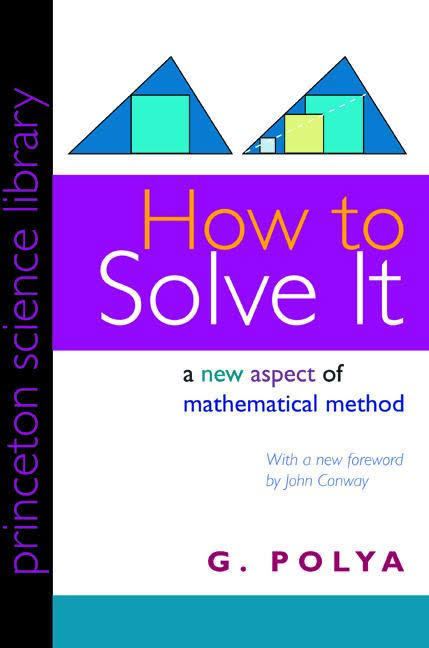8.4 /10 1 Votes
Originally published 1945 | 4.2/5 Goodreads | |||||||||||||||||||||||||||||||||
 | ||||||||||||||||||||||||||||||||||
Similar George Pólya books, Mathematics books | ||||||||||||||||||||||||||||||||||
How to Solve It (1945) is a small volume by mathematician George Pólya describing methods of problem solving.
Contents
Four principles
How to Solve It suggests the following steps when solving a mathematical problem:
- First, you have to understand the problem.
- After understanding, then make a plan.
- Carry out the plan.
- Look back on your work. How could it be better?
If this technique fails, Pólya advises: "If you can't solve a problem, then there is an easier problem you can solve: find it." Or: "If you cannot solve the proposed problem, try to solve first some related problem. Could you imagine a more accessible related problem?"
First principle: Understand the problem
"Understand the problem" is often neglected as being obvious and is not even mentioned in many mathematics classes. Yet students are often stymied in their efforts to solve it, simply because they don't understand it fully, or even in part. In order to remedy this oversight, Pólya taught teachers how to prompt each student with appropriate questions, depending on the situation, such as:
The teacher is to select the question with the appropriate level of difficulty for each student to ascertain if each student understands at their own level, moving up or down the list to prompt each student, until each one can respond with something constructive.
Second principle: Devise a plan
Pólya mentions that there are many reasonable ways to solve problems. The skill at choosing an appropriate strategy is best learned by solving many problems. You will find choosing a strategy increasingly easy. A partial list of strategies is included:
Also suggested:
Third principle: Carry out the plan
This step is usually easier than devising the plan. In general, all you need is care and patience, given that you have the necessary skills. Persist with the plan that you have chosen. If it continues not to work, discard it and choose another. Don't be misled; this is how mathematics is done, even by professionals.
Fourth principle: Review/extend
Pólya mentions that much can be gained by taking the time to reflect and look back at what you have done, what worked and what didn't. Doing this will enable you to predict what strategy to use to solve future problems, if these relate to the original problem.
Heuristics
The book contains a dictionary-style set of heuristics, many of which have to do with generating a more accessible problem. For example:
The technique "have I used everything" is perhaps most applicable to formal educational examinations (e.g., n men digging m ditches) problems.
The book has achieved "classic" status because of its considerable influence (see the next section).
Other books on problem solving are often related to more creative and less concrete techniques. See lateral thinking, mind mapping, brainstorming, and creative problem solving.
